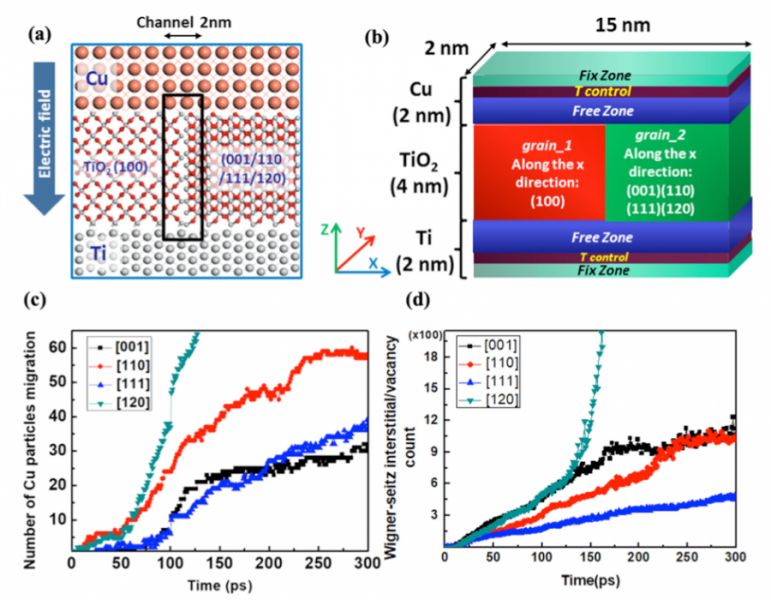新穎材料農業:友善環境農業新穎材料研發與安全評估【物理學系/何孟書教授】
| 論文篇名 | Impact of lattice plane orientation in TiO2 based resistive switching memory: A computational approach |
| 期刊名稱 | Applied Physics Letters |
| 發表年份,卷數,起迄頁數 | 2021, 862, 158035 |
| 作者 | Chen, Yu-Li; Balraj, Babu; Chung, Pei-Fang(鍾佩芳); Sivakumar, Chandrasekar(陳德森); Lee, Wen-Jay; Ho, Mon-Shu(何孟書)* |
| DOI | 10.1063/5.0037149 |
| 中文摘要 | 電阻式隨機存取存儲器 (ReRAM) 是非揮發存儲器的未來候選者。潛在機制涉及高k介電層中的電阻轉換,由於不同機制導致的電阻變化是由電和熱效應觸發的缺陷結構的演變引起的。對於 ReRAM 的存儲,可以使用電場來調整電阻材料的電阻以存儲資料。在這項研究中,使用電荷平衡方法進行非平衡分子動力學模擬來研究 ReRAM 的電化學反應。以 (100)/(001)、(100)/(110)、(100)/(111) 和 (100)/(120) 晶面為晶粒的 Cu/TiO2/Ti 異質結結構被認為是研究基於三個模型的電氣、熱和結構特性的電阻開關特性。具有雙晶結構晶界的介電層由二氧化鈦納米顆粒組成。我們的結果顯示,在晶界上施加的外部電場是電阻切換的關鍵問題。此外,仿真結果與實驗數據進行了驗證。總的來說,這項模擬工作提供了電阻轉換基本機制的細節,包括原子長度尺度和皮秒時間尺度上原子結構和電子特性的變化,這為未來材料的開發和優化提供了許多有用的方面。 |
| 英文摘要 | Resistive Random Access Memories (ReRAMs) are promising future candidates for nonvolatile memory. The underlying mechanism involves resistive switching in high-k dielectric layers, and changes in resistance due to different mechanisms are caused by the evolution of defective structures triggered by electrical and thermal effects. For the memory purpose of the ReRAM, the electrical field can be used to adjust the resistance of the resistance material for the storage of information. In this study, nonequilibrium molecular dynamics simulations with the charge equilibration method are used to study the electrochemical reactions of ReRAMs. The Cu/TiO2/Ti heterojunction structures with (100)/(001), (100)/(110), (100)/(111), and (100)/(120) lattice planes as grains are considered to investigate the resistive switching properties based on the electrical, thermal, and structural properties of three models. Dielectric layers with the grain boundary of the bicrystal structure are composed of titanium dioxide nanoparticles. Our results demonstrate that an applied external electric field on grain boundaries is a key issue in resistive switching. Furthermore, the simulation results were verified with the experimental data. Overall, this simulation work provides details of the fundamental mechanism of resistance switching, including variation of the atomic structure and electronic properties, at the atom length scale and picosecond timescale, which suggest a number of useful aspects for the future development and optimization of materials for this ReRAM technology. |
| 發表成果與本中心研究主題相關性 |
|







